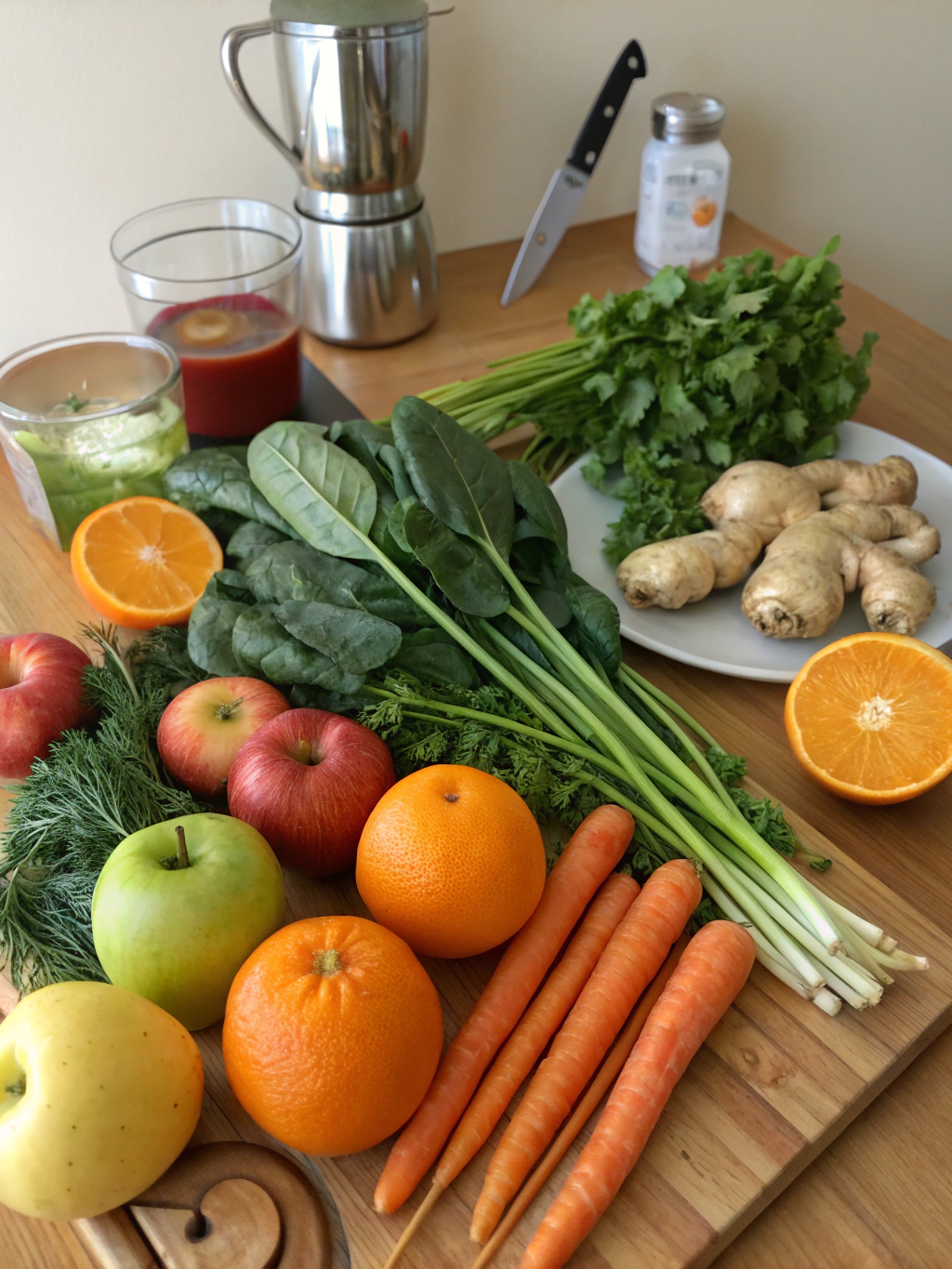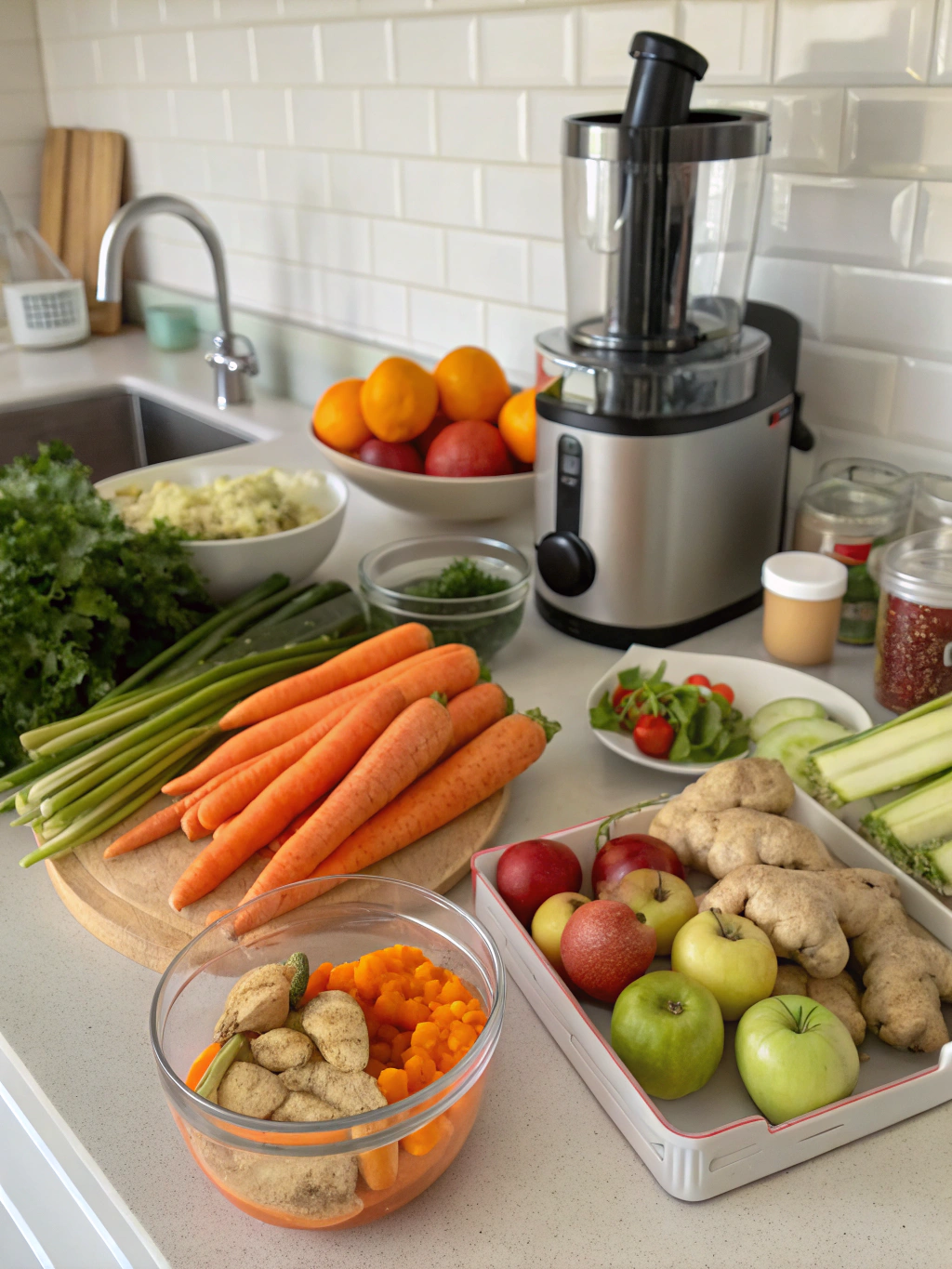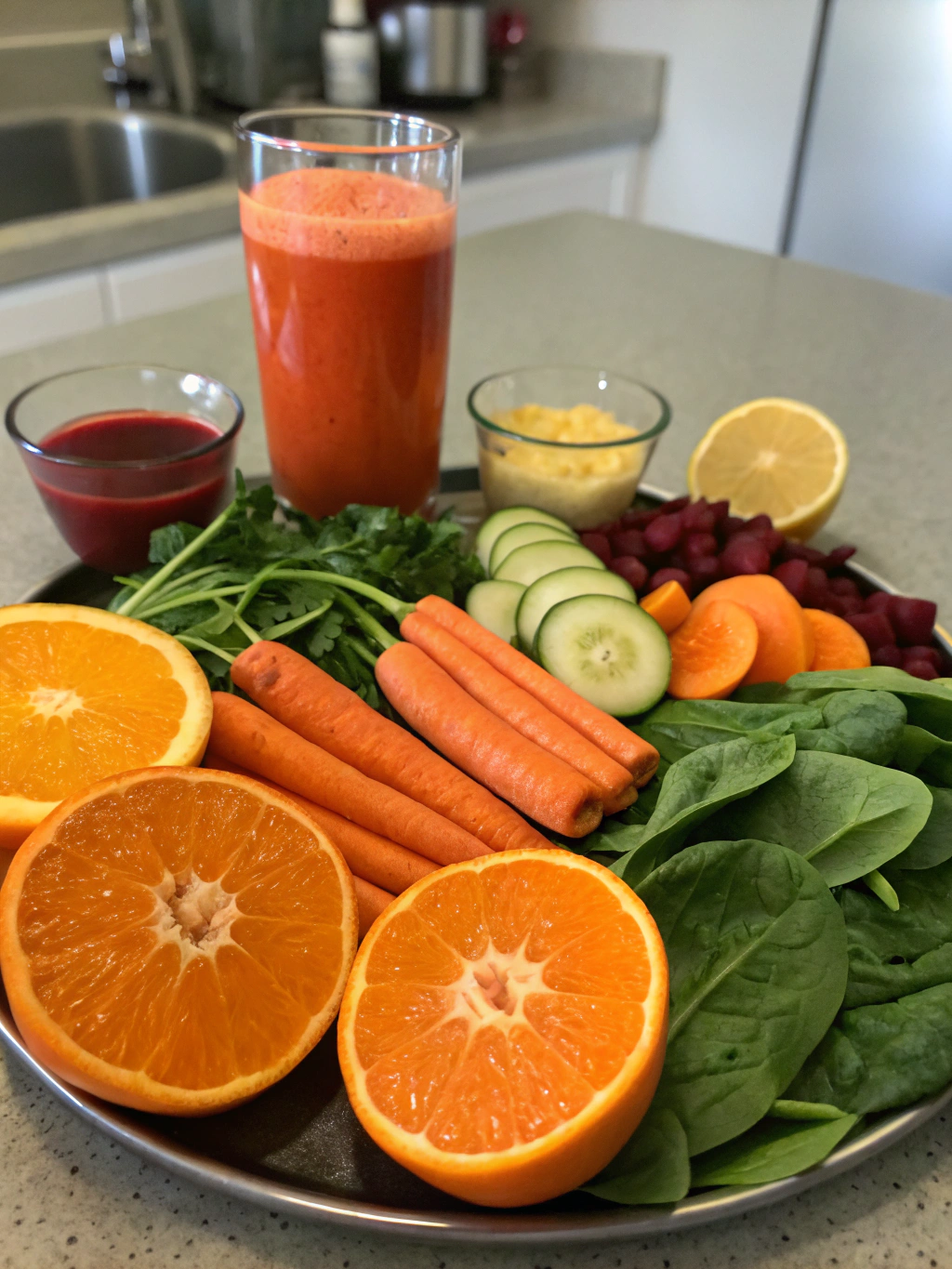Introduction
Ever wondered why so many health enthusiasts start their day with a vibrant glass of fresh juice? According to recent nutritional studies, just one serving of fresh vegetable juice can provide up to 70% of your daily recommended vitamin intake in a single, easily digestible form. Yet despite this impressive statistic, only about 10% of Americans consume the recommended daily amount of fruits and vegetables.
Looking for energizing juicing recipes? Discover 7 healthy drinks packed with nutrients to boost your energy and wellness. These recipes aren’t just delicious—they’re strategically formulated to deliver maximum nutritional benefits in every sip. From immune-boosting combinations to detoxifying blends, these juices might just revolutionize your health routine without requiring hours in the kitchen or hard-to-find ingredients.
Whether you’re a seasoned juicer or just beginning your wellness journey, these refreshing juicing recipes for detox and weight loss offer something for everyone—no expensive pre-packaged cleanse required.
Ingredients List

Each of these seven juicing recipes relies on powerhouse ingredients selected for both their nutritional profiles and complementary flavors. Here’s what you’ll need to create all seven recipes:
Fresh Produce
- Dark Leafy Greens: Kale, spinach, and Swiss chard (rich in vitamins A, C, K and minerals)
- Root Vegetables: Carrots, beets, sweet potatoes (packed with beta-carotene and antioxidants)
- Citrus Fruits: Lemons, limes, oranges, and grapefruits (high in vitamin C)
- Berries: Strawberries, blueberries, and raspberries (loaded with antioxidants)
- Tropical Fruits: Pineapple, mango, and papaya (containing digestive enzymes)
- Apples: Green and red varieties (provide natural sweetness and pectin)
- Cucumbers: For hydration and silica content
- Celery: For natural sodium and anti-inflammatory properties
- Ginger Root: 4-inch piece (anti-inflammatory and digestive aid)
- Turmeric Root: 3-inch piece (powerful anti-inflammatory compound)
Boosters and Add-ins
- Fresh Herbs: Mint, parsley, cilantro (detoxifying properties)
- Seeds: Chia or flax seeds (for omega-3 fatty acids)
- Nut Milks: Almond or coconut milk (for creamier textures)
- Natural Sweeteners: Raw honey or maple syrup (optional, for those transitioning to vegetable juices)
- Spices: Cinnamon, cayenne pepper (metabolism boosters)
Substitution Tip: Don’t have kale? Substitute any dark leafy green. Missing fresh ginger? A quarter teaspoon of dried ginger powder can work in a pinch, though the flavor will be less vibrant. The aroma of fresh ginger adds a warming zing that dried simply can’t replicate.
Timing
Prep Time: 10-15 minutes (30% less time with proper preparation)
Juicing Time: 3-5 minutes per recipe
Total Time: 15-20 minutes
Efficiency Tip: Washing and chopping all ingredients for multiple recipes at once can reduce your prep time by up to 40%. Most of these juicing recipes can be prepared in less time than it takes to brew and drink a cup of coffee, making them perfect for busy mornings.
Step-by-Step Instructions
Recipe 1: The Green Energizer
Step 1: Prepare Your Ingredients
Thoroughly wash 2 large kale leaves, 1 cucumber, 1 green apple, 1/2 lemon, and a 1-inch piece of ginger. Remove the kale stems if your juicer struggles with fibrous materials.
Step 2: Process Through Juicer
Begin with the softer ingredients (cucumber and apple), alternating with the kale to help push everything through efficiently. Finish with the lemon and ginger for a flavor punch.
Step 3: Serve Immediately
Pour into a glass and consume within 15 minutes to maximize nutrient retention. The vibrant green color signifies chlorophyll-rich content that helps oxygenate your blood.
Pro Tip: Adding a small pinch of sea salt can actually enhance the sweetness perception, making this green juice more palatable if you’re new to vegetable juices.
Recipe 2: Immunity Booster
Step 1: Prep Your Produce
Wash and cut 2 oranges (peeled), 1 carrot, 1/2 red bell pepper, and a 1-inch piece of turmeric root.
Step 2: Juice Components
Feed the ingredients through your juicer, starting with the oranges to create a liquid base that helps process the harder vegetables.
Step 3: Add Final Touch
Stir in a dash of black pepper—this increases turmeric’s bioavailability by up to 2000%, according to nutritional research.
Flavor Enhancement: A small sprig of fresh mint can brighten this immunity-boosting blend without adding calories.
Recipe 3: Berry Detox Blend

Step 1: Combine Ingredients
Prepare 1 cup mixed berries (strawberries, blueberries, raspberries), 1 beet (peeled), 1 apple, and 1/2 cucumber.
Step 2: Process Through Juicer
Alternate the berries with harder ingredients like apple and beet to ensure proper extraction.
Step 3: Enhance and Serve
Add a squeeze of lime juice to brighten the flavor and prevent oxidation. Drink immediately for best results.
Detox Tip: This particular blend helps support liver function—the beets contain betaine, which helps the liver process toxins more effectively.
Recipe 4: Tropical Morning Starter
Step 1: Gather Tropical Fruits
Prepare 1 cup pineapple chunks, 1/2 mango (peeled and pitted), 1/2 papaya (seeds removed), and 1 orange (peeled).
Step 2: Add Greens for Balance
Include a handful of spinach—its mild flavor disappears among the tropical fruits while providing essential nutrients.
Step 3: Juice and Enjoy
Process all ingredients, alternating between fruits and greens. Serve over ice for a refreshing morning energizer.
Digestive Benefit: The enzymes in pineapple (bromelain) and papaya (papain) aid protein digestion and can reduce inflammation.
Recipe 5: Hydrating Cucumber Refresh
Step 1: Prepare Hydrating Base
Clean 2 cucumbers, 4 celery stalks, 1 green apple, and 1/2 lemon.
Step 2: Add Herb Accent
Include a small handful of fresh mint leaves for digestive benefits and cooling flavor.
Step 3: Process and Chill
Juice all ingredients and serve over ice for maximum refreshment.
Hydration Insight: This recipe provides natural electrolytes from celery, making it ideal for post-workout recovery or hot summer days.
Recipe 6: Root Vegetable Revitalizer
Step 1: Clean Root Vegetables
Scrub and prepare 2 carrots, 1 small sweet potato, 1 apple, and a 1-inch piece of ginger.
Step 2: Add Citrus Element
Include 1/2 orange (peeled) to brighten the earthier flavors of the root vegetables.
Step 3: Process and Serve
Juice all ingredients, finishing with the ginger for a spicy kick.
Nutritional Note: This combination provides beta-carotene, which converts to vitamin A in the body, supporting eye health and immune function.
Recipe 7: Leafy Detox Special
Step 1: Prepare Greens Mix
Wash 2 cups mixed greens (spinach, kale, romaine), 1 cucumber, 2 celery stalks, and 1 green apple.
Step 2: Add Cleansing Accents
Include 1/2 lemon and a small bunch of fresh parsley or cilantro.
Step 3: Juice in Proper Order
Start with cucumber and celery to create a liquid base, then add greens and finish with apple and lemon.
Detoxification Insight: The chlorophyll in dark leafy greens helps bind to toxins in the bloodstream, while the herbs support kidney and liver function.
Nutritional Information
Understanding the nutritional profile of these juicing recipes helps you make informed choices based on your personal health goals:
Average Nutritional Profile (Per 8oz Serving):
- Calories: 100-150 (varies by recipe)
- Protein: 2-4g
- Carbohydrates: 25-30g
- Fiber: 1-2g (reduced from whole fruits/vegetables)
- Sugars: 15-25g (naturally occurring)
- Vitamin C: 80-120% of Daily Value
- Vitamin A: 50-200% of Daily Value
- Potassium: 400-700mg
- Antioxidants: High levels (particularly in berry and green recipes)
Research Insight: According to a study published in the Journal of Agricultural and Food Chemistry, fresh juices retain up to 90% of the antioxidants found in whole fruits and vegetables, making them an efficient delivery system for these beneficial compounds.
Green Juices (Recipes #1, #5, #7) are particularly low in calories (around 85-100 per serving) while providing the highest micronutrient density.
Fruit-Forward Juices (Recipes #3, #4) contain more natural sugars (20-25g) but also deliver higher levels of specific antioxidants like anthocyanins and vitamin C.
Healthier Alternatives
These refreshing juicing recipes for detox and weight loss are already designed with health in mind, but here are some adaptive options for specific dietary needs:
For Lower Sugar Content
- Diabetes-Friendly Version: Reduce fruit content by half and increase vegetables. For example, in Recipe #4, use 1/4 cup pineapple instead of 1 cup and add cucumber to maintain volume.
- Keto Adaptation: Focus on recipes #1, #5, and #7, which are lower in natural sugars. Add a tablespoon of MCT oil or avocado for healthy fats.
For Increased Protein
- Post-Workout Enhancement: Add a scoop of unflavored plant protein or collagen peptides to any recipe.
- Satiety Booster: Blend in 1/4 avocado or 1 tablespoon of nut butter (works especially well with Recipe #3).
For Specific Health Concerns
- Anti-Inflammatory Focus: Double the turmeric and ginger in Recipe #2, and add black pepper to enhance turmeric absorption.
- Digestive Support: Add 1 tablespoon of aloe vera juice to Recipe #5 for additional soothing properties.
Nutritionist Insight: While juicing removes fiber, which helps slow sugar absorption, you can add 1 teaspoon of psyllium husk to any juice to reintroduce soluble fiber without affecting the texture significantly.
Serving Suggestions
Elevate your juicing experience with these creative serving ideas:
Time-of-Day Optimized Servings
- Morning Energizers: Recipes #1, #4, and #6 are ideal breakfast companions, providing sustained energy without caffeine crashes.
- Afternoon Pick-Me-Ups: The hydrating properties of Recipes #3 and #5 make them perfect for combating the mid-afternoon slump.
- Evening Recovery: Recipe #7’s detoxifying properties support overnight cellular regeneration.
Pairing Recommendations
- With Meals: Serve Recipe #2 (Immunity Booster) with breakfast to enhance nutrient absorption throughout the day.
- Before Exercise: Recipe #6 (Root Vegetable Revitalizer) provides complex carbohydrates for sustained energy.
- After Workouts: Recipe #5’s electrolyte content makes it ideal for rehydration.
Presentation Ideas
- Garnish with Purpose: Float thin slices of the main ingredients on top (cucumber rounds, berry halves) for visual appeal and ingredient transparency.
- Layered Effects: For Instagram-worthy presentations, carefully pour different juices to create natural color gradients.
- Frozen Elements: Freeze small portions of the juice in ice cube trays, then use these flavor-concentrated cubes to keep your juice cold without dilution.
Seasonal Adaptation: In summer, serve over crushed ice with mint sprigs; in winter, try Recipe #6 slightly warmed (not hot) with a cinnamon stick for a comforting experience.
Common Mistakes to Avoid
Even with simple juicing recipes, there are pitfalls that can affect taste, nutrition, and the overall experience:
Preparation Mistakes
- Over-Relying on Fruits: This increases sugar content dramatically. Maintain at least a 60/40 vegetable-to-fruit ratio for balanced nutrition.
- Neglecting to Clean Produce Thoroughly: Pesticides and bacteria can concentrate in juices. Use a produce wash or vinegar solution for non-organic items.
- Using Bruised or Old Produce: Oxidized fruits and vegetables have lower nutrient content and can impart bitter flavors.
Equipment Issues
- Incorrect Juicer for Ingredients: Centrifugal juicers struggle with leafy greens, while masticating juicers process them efficiently. Match your machine to your ingredients.
- Insufficient Cleaning Between Batches: Flavors can cross-contaminate, and residue can affect performance. Rinse components between different recipes.
Consumption Errors
- Waiting Too Long to Drink: Fresh juices lose up to 40% of their nutrient value within 30 minutes due to oxidation.
- Drinking Too Quickly: Sipping slowly allows digestive enzymes in your saliva to begin processing the concentrated nutrients.
Nutrition Misconceptions
- Replacing Meals Entirely: Juices lack protein, healthy fats, and fiber needed for complete nutrition. Use them as supplements, not meal replacements.
- Ignoring Individual Responses: According to user feedback, approximately 15% of people experience a blood sugar spike with certain fruit-heavy recipes. Monitor your body’s response.

Storing Tips
While fresh is always best for maximum nutritional value, proper storage can help preserve both flavor and nutrients when you need to prepare juices in advance:
Short-Term Storage (Same Day)
- Airtight Containers: Use glass bottles or jars filled to the very top to minimize air contact.
- Temperature Control: Refrigerate immediately at 35-38°F (1.7-3.3°C).
- Light Protection: Store in opaque containers or wrap clear containers in aluminum foil to protect light-sensitive vitamins.
Extending Freshness (1-2 Days)
- Add Natural Preservatives: A squeeze of lemon or lime juice adds vitamin C, which acts as a natural preservative while brightening flavors.
- Vacuum Sealing: If available, vacuum-sealed containers can extend freshness by removing oxygen that causes oxidation.
Freezing Methods (Up to 3 Months)
- Ice Cube Trays: Freeze in silicone ice cube trays for portion-controlled servings that can be added to smoothies or defrosted as needed.
- Popsicle Molds: Transform Recipe #3 (Berry Detox) and Recipe #4 (Tropical Starter) into nutritious popsicles—a hit with kids and a refreshing summer treat.
Reawakening Stored Juices
- Re-activation Technique: Add a pinch of fresh ginger or a squeeze of citrus to revitalize flavors in stored juices.
- Texture Restoration: A quick blend or shake can reintegrate any separation that occurs during storage.
Storage Science: Research indicates that properly stored juices retain approximately 85% of their nutrient content after 24 hours, dropping to about 50% after 72 hours—making short-term storage viable for busy schedules.
Conclusion
Incorporating these seven juicing recipes into your wellness routine offers a practical, delicious path to increased nutrient consumption without overwhelming your daily schedule. Each recipe provides unique benefits—from the detoxifying properties of the Leafy Detox Special to the immune-supporting strength of the Immunity Booster.
The beauty of these recipes lies in their versatility. As you become more comfortable with the basic formulations, you can adjust them to your taste preferences and nutritional needs. Remember that consistency yields the most significant health benefits—a single juice occasionally won’t create lasting change, but making these nutrient-dense drinks part of your regular routine can transform your energy levels and overall well-being.
Have you tried fresh juicing before? Which recipe most appeals to your taste preferences? Remember that personalization is key to creating a sustainable healthy habit. Start with the recipe that sounds most appealing, then gradually experiment with more vegetable-forward options as your palate adapts.
For those seeking weight management support or detoxification benefits, the refreshing juicing recipes for detox and weight loss offered here provide a foundation you can build upon. Your journey to better health can begin with something as simple as a glass of fresh, vibrant juice.
FAQs
How do I know which juicer is best for these recipes?
For these versatile recipes, a masticating (slow) juicer generally produces the highest yield and preserves the most nutrients due to its gentle grinding action and minimal heat production. Centrifugal juicers work well for harder fruits and vegetables but may be less efficient with leafy greens like kale and spinach. If you’re just starting out, a quality centrifugal juicer is more affordable and will handle most ingredients adequately.
Can I prep ingredients the night before to save morning time?
Yes, you can wash and cut ingredients the night before to streamline your morning routine. Store prepped ingredients in airtight containers in the refrigerator. However, some nutrients begin to degrade once fruits and vegetables are cut, so while convenient, this method sacrifices some nutritional value. The compromise of slightly reduced nutrients versus no juice at all usually makes this a worthwhile strategy for busy individuals.
How much juice should I drink daily for health benefits?
Nutritionists typically recommend limiting fresh juice consumption to 8-12 ounces (240-350ml) daily due to concentrated sugar content, even from natural sources. This amount provides significant vitamin and mineral benefits without excessive calorie intake. Start with a smaller 4-ounce serving if you’re new to juicing, especially with green vegetable-based recipes, and gradually increase as your palate adjusts.
Will juicing help me lose weight?
Fresh juices can support weight management by providing nutrient-dense, satisfying options with fewer calories than many processed snacks. However, juicing alone isn’t a complete weight loss solution. The most effective approach uses juices as part of a balanced diet that includes adequate protein, healthy fats, and fiber. Green vegetable-based juices (Recipes #1, #5, and #7) are best for weight management due to their lower natural sugar content.
Are there any side effects I should be aware of when starting a juicing routine?
Some people experience digestive changes when beginning a juicing routine, including increased bowel movements due to the concentrated nutrients and natural cleansing effects. Start with smaller portions (4 ounces) and gradually increase to give your system time to adjust. Those taking blood-thinning medications should consult their healthcare provider before consuming large amounts of green juices, as vitamin K can interact with certain medications. Diabetics should monitor blood sugar responses carefully, particularly with fruit-forward recipes.
Can children drink these juices too?
These juices can be nutritious additions to children’s diets, particularly for picky eaters who may not consume enough vegetables otherwise. However, portion sizes should be adjusted based on age (roughly 2-4 ounces for young children), and fruit-forward recipes diluted with water to reduce sugar concentration. Recipe #4 (Tropical Morning Starter) and Recipe #6 (Root Vegetable Revitalizer) tend to be most appealing to younger palates.
How can I reduce waste from juicing?
The pulp byproduct from juicing contains valuable fiber and nutrients. Reduce waste by incorporating pulp into other foods: add vegetable pulp to soups, stews, or vegetable broth; use fruit pulp in muffins, quick breads, or compotes; compost remaining pulp for garden fertilizer. Some dedicated juicers even dehydrate pulp to make vegetable crackers or add it to homemade dog treats. These practices transform what would be waste into nutritional assets.

Leave a Comment